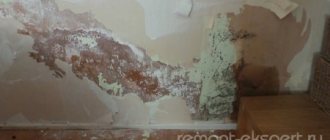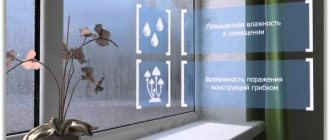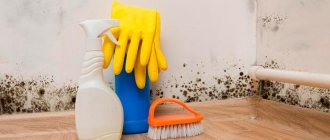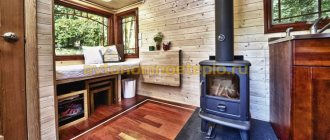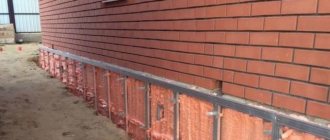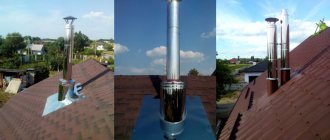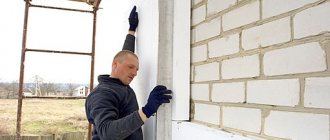Rating of the best wired headphones of 2021
In extreme cases, even significant damage to walls can occur. It starts with plaster. This works similarly to a glass bottle of water placed in the freezer. Freezing water molecules increase their volume, and as they expand, they destroy the structure of others that are in their path. When this happens in a layer of plaster, it begins to fall off the wall.
A wall in an apartment freezes most often due to the fact that a large amount of moisture accumulates in it. As a result, its surface becomes damp or wet. The reasons for this problem may be hidden in the following:
- Poor organization of the ventilation system. Because of this, the natural drying of the walls is significantly worsened. Liquid constantly accumulates in them, regardless of the factors why this happens.
- Insufficient heating during the cold heating season of the year. In this case, the premises in the houses do not warm up properly. Thus, the wall in the apartment freezes in a very short period of time.
- Low competence of the builders carrying out the construction of the building. Often, specialists, due to their laziness or lack of experience, poorly seal cracks directly next to window frames or between structural elements.
- Waterproofing that has become unusable. This problem most often occurs on the upper floors of multi-story buildings. If a wall in an apartment freezes, the owner must understand where to turn. Most often, the management company or housing office is responsible for waterproofing a house on the upper floors.
- The appearance of cracks in the house. This reason is considered by experts to be the most difficult to correct. This is due to the fact that in such situations the house needs to undergo major repairs. If work is not carried out to eliminate cracks, they will increase in size every year. This applies to both length and width.
In private houses, the owners themselves deal with this problem. In multi-apartment buildings, these deficiencies must be corrected by the management company or HOA. If the culprit of freezing is a developer organization that made mistakes during the construction of a house, it is necessary to file a complaint with it.
Cold bridges refer to those areas of the house that should initially be insulated. These include all corner parts. Builders are required to insulate them and use special insulation
Important! Internal insulation has a number of advantages. You will not need to obtain permission to transform the facade from the management company
In addition, you can insulate the apartment from the inside on your own.
What to do
Before choosing a crack repair method, it is advisable to conduct a test to determine the condition of the structure and find out whether the process continues or not.
To do this, take a paper tape, indicate the date of its installation, and then monitor the process for several months. If the tapes remain intact, then the process has stopped. If the tape breaks, it is first important to find out the reason in order to understand how to proceed.
If the crack does not grow, it is sealed with heat-insulating material and then plastered. When the facade is lined, it is impossible to do without partially relaying the bricks.
Having studied all the factors that cause the crack to expand, choose the following method to solve the problem:
- to fasten the masonry walls, use metal conductors,
- partially relay the wall,
- lengthen the current wall or strengthen the internal ones, which will create additional strength and immobility of the building,
- carry out work to strengthen the foundation. The most difficult method, requiring the help of not only a specialist, but also special equipment.
Related article: Plastering walls from OSB boards
Walls and corners in a brick house freeze due to disruptions in construction or incorrect design. It is best to resort to an external method of eliminating this drawback, but additional internal heat and waterproofing will be cheaper.
A wall in a panel house freezes. What to do
Of course, in each specific case you need to approach the issue individually, but we will still try to give a general algorithm of actions. So:
- It is necessary to establish the cause of freezing. In this case, the reason is not the watering of the insulation, but the determination of the location of defects through which water enters the wall.
The best option is to do a thermal imaging examination. In this case, you can rely not on subjective sensations, but on objective data from the conclusion. Survey data may be useful in resolving issues with the management company. The second plus is the integrity of the picture, that is, you will see all the places where heat escapes through the wall. The downside is that such an examination requires a thermal imager, which means you will have to turn to professionals. Thermal imaging examinations are naturally carried out in winter.
Frozen corner. The temperature on the wall surface is below the dew point, so the wall gets wet
If it is not possible to do thermal imaging, we will examine the wall ourselves. Condensation, fungus, and mold clearly indicate freezing. In addition, there may be cooler areas. This happens if metal embedded parts are hidden inside (under plaster or concrete sealing). By the way, they can be in the most unexpected, non-design places, since builders are unpredictable people.
In this house, heat is given off by the joints and metal elements in the middle of the panels
Also, cold places will be in voids, or where the waterlogging of the insulation is not yet too great. Without special equipment, you can determine the location of cold spots simply by feeling the wall with your hands. In addition, it would not be a bad idea to go through the wall with a lighter or candle to check for through blowing. Check the panel joints, corners, baseboards, window openings and slopes especially carefully. It is better to check by removing the wallpaper so that the joints are visible.
On the upper floors, moisture very often leaks into the panel through a poorly executed roof
Particular attention should be paid to the junctions with the parapet. The parapet slab is obviously much thinner than the wall slab, and if the roof leaks here, the water goes into the wall and has nowhere else to go.
Therefore, together with a representative of the management company, we inspect the junctions and drainage system from the roof for leaks and operability.
- Repair defects. Qualitatively seal panel joints and roofing (if necessary). Foam holes and voids.
- Dry the wall. It is necessary to get rid of moisture in the panel insulation. If this is not done, the wall will become damp, “sweat” and “cry” for several years until it dries completely. To do this, we insert tubes made of dense polyethylene into the sealing layer between the wall panels. A spirit level tube will do. Through them, water oozes (sometimes pours) out. We dry the remaining moisture with a heat gun or a conventional converter-type electric heater. The last option is even preferable: the fungus really does not like air movement.
- Insulate the wall. We carry out this step if the thermal resistance of the wall is insufficient. Unfortunately, determining whether this is true will most likely have to be done empirically. Talk to your neighbors. If the exterior walls of the entire house are cold, it makes sense to install additional insulation. It is necessary to insulate the outside so as not to turn the house into a vapor-tight thermos (see details). For floors above the first, industrial climbers are used for insulation.
- Get rid of fungus and mold. Drying the wall alone is not enough. Read about additional measures to combat mold.
- Adjust ventilation if it does not work or does not work well enough. The advice in this article will help you check this and take action.
In conclusion, I would like to note that only serious comprehensive measures will help get rid of freezing of walls. But this is how you can return warmth to your home, make it comfortable and cozy.
Good luck to you and see you on the blog Remont-Dlya-Vseh.ru.
The wall is “cold”
It is far from a rare case that the walls do not freeze, become damp or become covered with fungus; they simply “feel cold” and create the feeling of a draft. Such discomfort occurs when the temperature difference between the indoor air and the inner surface of the wall is more than 4°C.
There may be several reasons for a decrease in the temperature of the inner surface of the wall below the standard: unsatisfactory operation of the heating system, a decrease in the thermal resistance of the wall due to wetting, or a common defect made at the design or construction stage of the house. For example, a wall facing an unheated entrance may turn out to be cold. It was originally designed as an internal wall separating two rooms, the air temperature in which is approximately the same. However, if the heating radiators in the entrances do not work or there are none at all, and the windows and doors of the entrances are broken, then the air temperature in the entrance decreases. The relatively thin internal wall perceives the entrance room “as a street” and the temperature of its internal surface drops below the standard, and the wall itself acts as a radiator to heat the entrance. A dry external wall of the designed thickness, during the construction of which there was a construction defect, for example, incomplete filling of the brickwork joints with mortar or incorrect cutting of the joints between panels in panel houses, can also turn out to be cold.
The easiest way to completely insulate a cold and dry—we emphasize this word, dry—wall is to hang a carpet on it. Although this is not fashionable, it is quite effective. A carpet covering the entire wall will increase the temperature of its inner surface and the wall will no longer “pull the cold” so much. If this method seems unacceptable to you, then the wall is completely insulated. However, the goal of such thermal insulation should not be to achieve modern thermal engineering standards; as has been repeatedly said, internal insulation does not bring the desired effect, but, on the contrary, aggravates the situation.
The goal of insulation should be to increase the temperature of its inner surface to the standard one, that is, in fact, we should not insulate the wall, but simply increase its thickness so that the temperature difference on the inner surface of the wall and the air inside the room is no more than 4 ° C.
No matter how strange it may sound, it is advisable to carry out internal wall insulation without insulation. And if you use insulation, it is better to use thin foil insulation with careful sealing of the seams with aluminum tape. The foil should be directed towards the room. If you decide to insulate the walls using slab cotton wool or foam insulation, then a thermal engineering calculation must be made, including calculations for dew in the thickness of the wall or insulation and summing up the annual moisture balance of the wall. The thickness of the insulation must be selected using thermal engineering calculations. In this case, you need to be guided not by the achievement of modern thermal technical standards for the thermal resistance of the wall (this is the case when it is better to ignore the standard), but to find the optimal option for the thickness of the insulation, in which moisture will not condense on the inner surface of the wall. If this is not possible, then the annual balance of moisture accumulation in the wall should be negative, that is, the moisture accumulated in it in winter should be evaporated in summer. Such calculations are a complex engineering task and must be done by specialists.
One of the easiest ways to insulate interiors without insulation is to replace plaster walls with plasterboard sheathing. However, this method is only suitable for rooms with a dry and normal microclimate. For rooms with high air humidity, it is better to replace ordinary drywall with moisture-resistant or fiberboard (MDF-T, MDF), oriented strand boards (OSB), cement-bonded particle boards (CSP), moisture-resistant plywood, PVC wall panels or wooden lining. These materials are attached to the wall using glue, for example, this is how drywall is attached, or to a frame. If it is very necessary, then before installing the frame, foil roll insulation is glued to the wall, the joints of which are protected from the penetration of steam from the room with aluminum tape. Thus, an air gap is created between the insulation, protected on the room side by a vapor barrier, and the inner surface of the wall cladding. The thickness of the air gap should be no less than 20 and no more than 50 mm.
The use of thin thermal insulation material gives a chance to leave a zero temperature isotherm in the thickness of the wall, that is, to prevent it from freezing through. However, it is advisable to determine the dew point temperature isotherm and the probability of condensation by calculation. Otherwise, insulation in which steam will condense, for example, on the insulation foil and flow onto the ceiling, is worthless. As practice shows, insulating walls with thick sheets of slab insulation (from 50 mm and above) almost always leads to dew falling at the boundary of the wall and the insulation. The use of thin roll insulation reduces this likelihood, but steam can condense on the foil layer. Creating an air gap between the insulation and the wall finishing helps “dry” the foil. It is better if the air gap is not closed, but open near the floor and ceiling, but for interior decoration this is a difficult task to solve. Ventilated air does not fit well with the interior of the room.
To eliminate the discomfort associated with a decrease in the temperature of the inner surface of the wall below the standard, it is often sufficient to simply increase the thickness of the wall with sheathing without the use of insulation, with a tight fit of the sheathing to the wall. By making such a generally simple design, we do not greatly reduce the living space and do not interfere much with the temperature and humidity conditions of the wall, but at the same time we raise the temperature of its inner surface. The temperature isotherm of the inner surface of the wall remains under the sheathing, and the temperature on the surface of the sheathing will be higher and there will no longer be a “cold pull” from the wall.
Reasons for wall freezing
A cold bridge occurs when the walls are not constructed correctly.
Determining the cause of wall freezing is not such a simple matter. Walls can freeze in any house: brick and panel type, regardless of their location.
It is clear that the walls begin to freeze due to the appearance of the so-called cold bridge. The question under what conditions it can arise is worth examining in more detail.
Often freezing of walls goes hand in hand with dampness and the formation of fungus
The main reasons for its appearance include:
- depressurization of interpanel seams;
- small wall thickness of a panel house (not suitable for climatic conditions);
- filling the walls with moisture both from the inside and outside (internal flooding with water from neighbors, rainwater entering a damaged seam);
- destruction of the building foundation leads to divergence of panels and cracking of brick walls;
- leaky joint between closely located houses (distance from 0.5 to 2 m).
All of the above reasons can occur equally often. Each of them has distinctive characteristic manifestations.
Violation of the integrity of the seams can cause the formation of a cold bridge
The cause of the outbreak and destruction of the seam between the panels may be:
- using unsuitable material (mastic, sealant) to seal joints (the location of the house and external environmental conditions play a big role);
- the work carried out to insulate the joints was carried out by unqualified specialists, as a result of which voids remained in the sealed joint, where moisture gets in, which changes its state with temperature changes and destroys the wall;
- The external wall insulation produced is not of high quality (if it was produced).
Cold bridges can appear not only in block buildings; a wall in a brick house where there are no panels or seams between them can also successfully freeze. In this case, the cause is often an excessive amount of moisture in the apartment or a decrease in room temperature.
Cold corner
The temperature in a room or apartment may decrease for the following reasons:
- poor sealing of window openings (product production or installation work was not carried out according to technology);
- The entrance doors to the premises are not installed tightly and hermetically;
- blows from the ventilation system;
- airiness of the heating system;
- low temperature for heating the room.
Walls saturated with moisture also run the risk of freezing in winter.
Many owners do not even realize that they can make a freezing wall on their own without knowing it.
By carrying out wet cleaning of premises quite often during the cold period, incorrectly storing vegetables on the balcony and frequently watering a large number of indoor plants, each of us can harm ourselves by saturating the wall of the building with excess moisture.
To prevent such processes from happening, it is necessary to frequently ventilate the room and prevent waterlogging in the rooms.
Causes
Freezing of walls is not uncommon; this disrupts the microclimate in the house and even the well-being of people. The causes of the problem may be:
- poor seam sealing,
- lack of insulation,
- the presence of through voids inside the masonry,
- lack of solution.
Failure to comply with technical standards or the usual negligence of builders leads to the fact that the wall cannot fully perform its functions.
Due to the reasons listed above, “cold bridges” appear, due to which the cold penetrates deep into the wall, which manifests itself in condensation. This process is explained by a shift in the dew point, which ideally should be outside.
Related article: Attachment for a drill for gating walls
When the structure of the brickwork is damaged, the point of contact between warm and cold air shifts, which is the cause of condensation inside the room.
Regular wetting of the surface and warm air provokes the formation of mold . In winter, when the air temperature is significantly reduced, the condensation freezes, turning into ice fungus. This situation requires immediate identification of the causes and their elimination.
A corner in the house freezes. What to do Solutions.
Siding is a new trend in modern construction. With the help of siding you can not only insulate, but also decorate your home. In this article, we describe in detail the siding installation process.
If none of the organizations to which the appeal was made takes any action, it is necessary to address the complaint to such government bodies as:
- prosecutor's office;
- city or district administration;
- Maintenance of housing inspection;
- court.
When this cold bridge comes into contact with the warm air of the room, the following physical phenomenon occurs on its surface - a “dew point” is formed, i.e. water vapor contained in the air begins to condense and turn into droplets. The wall begins to get wet in this place, and in winter, when the temperature drops, it naturally freezes.
Every person expects a cozy environment when returning home, but it is difficult to maintain a feeling of warmth in a room with frozen walls. This problem is especially common in old panel houses.
Troubleshooting
The problem of freezing can be eliminated by organizing internal or external insulation.
If you independently discover zones of freezing in the walls, you should immediately take appropriate measures to eliminate this problem.
There are often situations when residents of an apartment building cannot get the heating network to add heating power, and electricity tariffs are constantly rising, and there is no other option but to insulate the premises themselves.
Before you start insulating your apartment, you need to decide which of the options for thermal insulation of the room you will choose: internal or external insulation.
To produce external insulation, it is necessary to invite industrial climbers or use the services of an elbow tower.
Internal insulation of a room, wall or apartment as a whole can be done independently, but this will significantly reduce the volume of the room. So, which of the options for sealing and sealing the wall to choose is up to each owner to decide individually.
Additional insulation
Most often, the outside of the house is insulated with polystyrene foam.
As mentioned above, 2 types of thermal insulation can be used for a frozen wall: external and internal.
Despite the fact that qualified workers are hired to insulate the building from the outside, every owner should know how this process occurs.
When performing external work on façade insulation, polystyrene foam is used as insulation, which is glued to the wall and fixed to dowels in the form of a “fungus”.
After that, the outer surface of the insulating material is reinforced with a plaster mesh (glued to an adhesive composition), onto which a decorative coating is applied in the form of facade paint or decorative plaster.
You can see a clear example of layers of external insulation in the diagram below.
To carry out internal work on wall insulation, an additional frame is created from an aluminum profile or wooden blocks. The width of the frame depends on the thickness of the insulation used.
When creating additional thermal insulation for indoor spaces, mineral stone wool is most often used, since it does not contain harmful impurities and has excellent thermal conductivity.
A layer of vapor barrier coating is attached on top of the installed insulation mats to protect against moisture penetration. For more information about the physics of wall insulation, watch this video:
For internal insulation of premises, it is recommended to use mineral wool of maximum density. Despite the fact that such a product will be quite expensive, you can resort to minor reductions in the room, while creating good thermal insulation and sound protection.
When is a thick wall good?
Thick stone walls are good for Mediterranean and tropical climates: there is no danger of freezing, seasonal and daily temperature fluctuations are smoothed out, and in hot weather you can do without air conditioning.
Thick walls are risky and expensive. But well-insulated thin masonry of half or a quarter of a brick is another, completely unjustified extreme. The fact is that a moderately massive stone wall, protected from heat loss, is capable of accumulating thermal energy and gradually releasing it into the space of the room. Warm, dry, brick walls are an excellent source of soft home warmth. They, like a sponge, absorb the energy of water heating systems or infrared emitters, and themselves become secondary sources of infrared energy. Comfortable conditions in such a room are quickly restored even after intensive cross-ventilation; You can place both a bed and a work desk next to thick, well-insulated walls - their surface will not “cool”.
Eliminating dampness in corners
Attentive owners will always notice damp corners in time and determine the cause of the appearance of phlegm.
After identifying the culprit of the problem, you can begin to eliminate it:
If the wall freezes, you need to take measures to insulate it. The most effective way is to insulate the walls from the outside. It will not only reduce dampness, but also reduce heat loss. This is done either with mineral wool or polystyrene foam. However, for owners of apartments in high-rise buildings, such insulation is quite a troublesome task. If problems arise with external insulation, you can insulate the wall inside the room.
When applying insulation from the inside, thermal calculations should be made to avoid the appearance of condensation and moistening of the insulation material, as a result of which its insulating properties are lost.
- To make the correct calculations, the humidity in the room, climate, degree of thermal conductivity of the wall, etc. are taken into account, so in such cases, expert advice is simply necessary.
- If the heating system is inefficient, additional sources of thermal energy should be used. This could be an electric fireplace, a stationary battery, a radiator or other alternative heaters, which are recommended to be installed in places where there is the most dampness.
- If condensation appears due to excessive tightness of the room after installing plastic windows, the room should be ventilated more often.
- If the walls are not thick enough, it is recommended, if possible, to line the outside of the building with an additional ball of brick or apply insulation under the plaster. You can insulate the walls from the inside with slab insulation (foam plastic, mineral wool), placed on the frame with 5 cm wide walls to fill it with expanded clay. This building material will absorb moisture from a damp wall and prevent the spread of mold.
- Ventilation can be improved by installing an additional hood, and at the bottom of the door at the entrance to a separate room you can make a gap to regulate the air. Ventilation should also be improved in the bathroom and kitchen, which are most often sources of dampness.
- If there is a basement underneath the home, moisture can penetrate through microcracks in the floor, causing the walls to become damp. To eliminate this problem, the floor is treated with an antifungal agent, a moisture-resistant base is laid on it, and all cracks are sealed with sealant.
- If the cause of damp corners is fungus and mold that has appeared in the wall on the plaster, then all affected areas are treated with antifungal solutions, plastered again, if necessary, with a high-quality mixture, and only after that new wallpaper is glued.
- If balcony slabs are installed poorly, moisture penetrates into the seams, so the joints between the slab and the wall should be sealed so that there are no leaks that lead to damp spots.
- When caulking seams in external walls, care should be taken to ensure that closed and open joints provide air protection, and that the latter are well protected from moisture.
What should you do if a wall freezes in a brick house?
Thus, there are a large number of options for what to do if the wall in the apartment is frozen. All of them are worth considering before choosing one or another way to solve the problem.
Many residents use external wall insulation to prevent their walls from freezing. Especially if this wall is corner in your house. Although many say that this insulation will not provide much benefit, sometimes just a few degrees will be enough for the dampness to go away. Complaining is the last thing. First you need to try to solve the problem yourself.
Homogeneity and low permeability make the thermal insulation properties of ecowool quite competitive.
First of all, the walls must dry thoroughly. Therefore, you should not start insulating immediately with the onset of spring, because the moisture will remain in the walls. After insulation is completed, you can see inside the unsightly and not very healthy stains of moisture, fungus and mold.
The apartment itself is on the corner and in winter this problem occurs. But I know for sure that it is useless to demand anything from the housing and communal services, since after all, I live in this apartment, and I have to worry about my well-being. That’s what I do, I insulate the walls, in addition, I direct heaters to the walls, and most importantly, I don’t think about the bad and about what the whole World, along with the housing and communal services, owes me. No one will worry about me but me.
The apartment is on the top floor. Corner. The roof was leaking, the riser was clogged, the radiators were barely warm. A fungus started growing in the corner from the ceiling down the wall. I had to strip everything down to bare walls and treat it with copper sulfate. All this is long, tedious and costly... Definitely the fault of the Housing Office, because... he is in charge of the roof and the risers in the interfloor ceilings.
Let us tell you that the reasons for icing are violations of waterproofing, vapor barrier and thermal insulation of seams. This formation of “cold bridges” is typical for freezing of a brick wall and a panel wall.
Ecowool consists of fluffed cellulose (81%), which is obtained by processing waste paper. The composition also contains fire-retardant additives (12%) and boric acid (7%), which protects floors from fungi and bacteria.
Freezing water molecules increase their volume, and as they expand, they destroy the structure of others that are in their path.
You can do this yourself; if necessary, hire qualified craftsmen. It can take quite a lot of time to treat a wall, since the surface must be completely dry before restoring its appearance.
What to pay attention to:
- pronounced seams,
- local painting of walls,
- during a thaw, visible stripes on the outside of the wall,
- moisture stains on the walls indoors, often under windows,
- mold and mildew on the interior walls.
You can do this yourself; if necessary, hire qualified craftsmen. It can take quite a lot of time to treat a wall, since the surface must be completely dry before restoring its appearance.
There is an architectural way to avoid the formation of so-called geometric “cold bridges” - the construction of beveled or rounded corners of the building. But not everywhere, for obvious reasons, this method can be applied. However, it is quite possible to install pilasters or other decorative elements on the façade.
Insulating walls from the inside: a whim or a necessity? A wall in a brick house freezes: what to do? Where to contact?
The question interests all owners. Failure to comply with building codes is the most common cause of failure of the thermal insulation of a building. In turn, such problems not only lead to a decrease in the temperature inside the building, but also contribute to the development of mold, which occurs in those places where the insulation is weakest.
Each of these materials has its own advantages and disadvantages. Both will protect walls from direct contact with moisture and low temperatures. However, mineral wool, as a completely natural product, will provide the building not only with high thermal insulation, but also with high vapor permeability.
The lower the humidity, the lower the condensation formation temperature should be, i.e., it is more difficult to freeze the condensate. For this reason, hoods are installed in rooms with sources of moisture.
Why do walls freeze? The reasons for freezing of walls are, most often, the mistakes of careless builders, coupled with the laws of nature, or, more precisely, thermodynamics. As you know, the external walls of the house should serve as heat insulators - not to let heat outside and cold inside the room.
Ways to get rid of freezing of walls and corners in a brick house
If a corner freezes and its structure is clearly damaged, that is, it has cracks or severe deformations, then polyurethane foam serves as an excellent means of combating similar problems. It is quite simple to use, and to carry out the work you will need no more than half an hour of free time. At the same time, blowing out voids and sealing cracks should limit the access of cold air into the room, which will help get rid of the negative consequences of wall freezing.
Heat-protective plaster can also be a pretty good option. However, its use is possible only in those places where freezing is not too obvious. This criterion is incredibly important, since a relatively small layer of plaster is simply not able to isolate large flows of cold air.
In general, the best option is to combine both of the above methods. In this case, the crack is first blown out, and then a layer of thermal insulating plaster is applied. Combining these insulation options makes it possible to completely eliminate freezing of corners and restore the microclimate in the room.
Insulating the surface by applying a thermal insulation layer to it is also a good solution. However, the greatest efficiency can only be achieved by creating a solid monolithic layer that will cover the entire wall. At the same time, a similar technique can be used both on the inside of the building and inside it.
Most often, for similar work, polystyrene foam is used, which is glued directly to the wall, and the junctions of the sheets with each other are covered with a special reinforcing putty, providing the given section of the wall with the necessary heat preservation qualities.
It’s better to start fighting freezing in the spring
Freezing of the walls of the house is one of these problems, which, of course, is easier to prevent than to eliminate the consequences of negligence later. What can be done if wall freezing is a problem in our home?
The bad news is that if we notice a problem in the winter, it's nothing at the moment. Good: in one season the house will not collapse, and in the summer it will be possible to begin treatment.
First of all, the walls must dry thoroughly. Therefore, you should not start insulating immediately with the onset of spring, because the moisture will remain in the walls. After insulation is completed, you can see inside the unsightly and not very healthy stains of moisture, fungus and mold.
You can trust the sun to dry your walls in spring and summer. If this doesn't work, for example on the north side of the house, it's worth investing in drying. The best time for this will be at the end of summer. And in the spring we will fight the appearance of mold and mildew, which must be treated with appropriate fungicidal preparations. It happens that even repeated use of the drug is required before the problem disappears.
Advice for those who have frozen walls in their home
It is most likely not worth filing an application with the management company regarding wall repairs, since they will not do repairs at the company’s expense
To force those in charge to pay attention to you, write a collective statement so that the initiative comes from the majority. If you decide to do the insulation of the panels yourself from the outside, first you need to obtain the appropriate permission from the housing department or other management company
Foam plastic is mainly used to insulate panels on the outside. This material is not of high quality, but is applicable in this situation. The first step in repairing freezing walls is to find the cause of such freezing. Next, you need to clean all the places where mold has appeared, then we proceed directly to the repair work. If you don't do all the steps in order, you risk wasting money.
Dear readers! If you still have questions on the topic “What to do if the wall in your apartment freezes” or have other questions, ask them right now - use the online consultant form or call us at 8(800)-350-30-02 (call and consultation is free for all regions of Russia)! Was the Recording helpful? 64 out of 99 readers found the post useful.
How to stop freezing of a wall in an apartment?
An apartment on a high floor is an option when it is difficult to insulate the outside of the house. Especially in panel houses, you can often see seams painted with sealant, and sometimes cracks on the panels themselves. But calling industrial climbers at your own expense to go through these problem areas again is expensive. How to stop freezing of a wall in an apartment? It’s easier to use the thinnest thermal insulation that exists. These are special liquid mixtures, which are often also paints. If you like painted walls, this is definitely your option. You just need to first find possible problem areas. If there are voids in the seam or the slab itself, then it is worth pumping foam into it, and the fungus must be removed from the walls.

